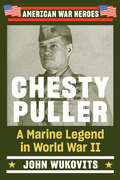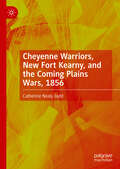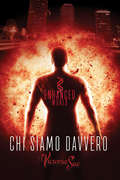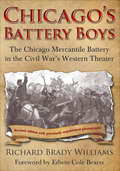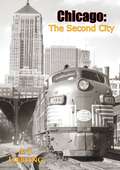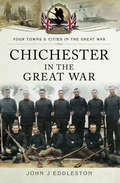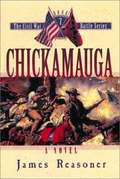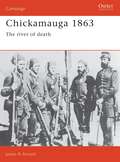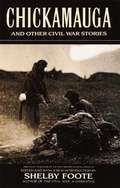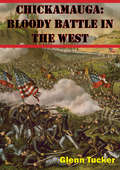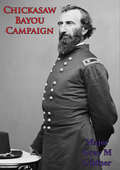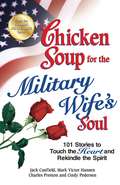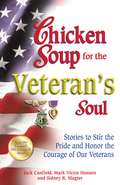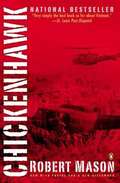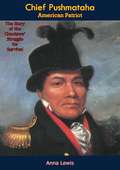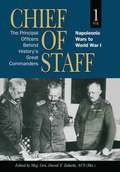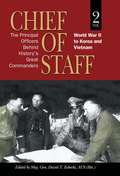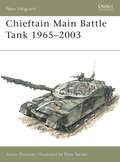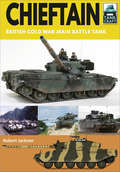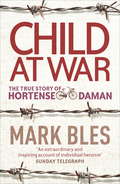- Table View
- List View
Chesty Puller: A Marine Legend in World War II (American War Heroes)
by John WukovitsThe dramatic battlefield story Chesty Puller, Marine hero of World War II In 1942, when Chesty Puller first stepped foot onto Guadalcanal in America&’s first major land campaign against Japan, he had already served two remarkable decades as a US Marine. Yet it was on that Pacific island where the Puller legend would come to life. For months, Chesty and his Marines fought the Japanese in close-up jungle combat, at times resorting to bayonets and even fists. During the Battle for Henderson Field, Puller&’s Marines held off wave after wave of enemy attackers over the course of three consecutive nights. His courage under fire and unbreakable devotion to his men inspired not just those under his own command but Marines everywhere. As the war marched on, one bloody battle after another, from Guadalcanal to Peleliu, Chesty became the most decorated Marine in US history. Now, acclaimed military historian John Wukovits, author of Pacific Alamo, tells the story of Chesty Puller's incredible valor and combat leadership in the Pacific War.
Cheyenne Summer: The Battle of Beecher Island: A History
by Terry MortEvoking the spirit—and danger—of the early American West, this is the story of the Battle of Beecher Island, pitting an outnumbered United States Army patrol against six hundred Native warriors, where heroism on both sides of the conflict captures the vital themes at play on the American frontier.In September 1868, the undermanned United States Army was struggling to address attacks by Cheyenne and Sioux warriors against the Kansas settlements, the stagecoach routes, and the transcontinental railroad. General Sheridan hired fifty frontiersmen and scouts to supplement his limited forces. He placed them under the command of Major George Forsyth and Lieutenant Frederick Beecher. Both men were army officers and Civil War veterans with outstanding records. Their orders were to find the Cheyenne raiders and, if practicable, to attack them. Their patrol left Fort Wallace, the westernmost post in Kansas, and headed northwest into Colorado. After a week or so of following various trails, they were at the limit of their supplies—for both men and horses. They camped along the narrow Arikaree Fork of the Republican River. In the early morning they were surprised and attacked by a force of Cheyenne and Sioux warriors. The scouts hurried to a small, sandy island in the shallow river and dug in. Eventually they were surrounded by as many as six hundred warriors, led for a time by the famous Cheyenne, Roman Nose. The fighting lasted four days. Half the scouts were killed or wounded. The Cheyenne lost nine warriors, including Roman Nose. Forsyth asked for volunteers to go for help. Two pairs of men set out at night for Fort Wallace—one hundred miles away. They were on foot and managed to slip through the Cheyenne lines. The rest of the scouts held out on the island for nine days. All their horses had been killed. Their food was gone and the meat from the horses was spoiled by the intense heat of the plains. The wounded were suffering from lack of medical supplies, and all were on the verge of starvation when they were rescued by elements of the Tenth Cavalry—the famous Buffalo Soldiers. Although the battle of Beecher Island was a small incident in the history of western conflict, the story brings together all of the important elements of the Western frontier—most notably the political and economic factors that led to the clash with the Natives and the cultural imperatives that motivated the Cheyenne, the white settlers, and the regular soldiers, both white and black. More fundamentally, it is a story of human heroism exhibited by warriors on both sides of the dramatic conflict.
Cheyenne Warriors, New Fort Kearny, and the Coming Plains Wars, 1856
by Catherine Nealy JuddIn this book, Catherine Nealy Judd demonstrates the profound significance of a U.S military siege rashly launched from Fort Kearny against a small war party of Northern Cheyenne. This event occurred on the Platte River Road in August 1856 and triggered four Cheyenne reprisal counterattacks. Drawing on history, anthropology, geography, cultural studies, military records, governmental archives, diaries, letters, and other primary sources, Judd scrutinizes a tumultuous moment in the pre-railroad expansionist era, presenting her readers with a tale of struggle between Indigenous Americans and an increasingly aggressive federal military stationed at the forts of the Plains. As Judd scrutinizes the causes, conduct, and consequences of this long-neglected series of events, her insights encourage us to reassess the trajectories of federal aggression and of an Indigenous response to that bellicosity. By placing the Cheyenne Nation at the center of the history of the Overland Trail, this study offers a long overdue reinterpretation of the Platte River Road in the 1850s and beyond.
Chełmno and the Holocaust
by Patrick MontagueAs the first extermination camp established by the Nazi regime and the prototype of the single-purpose death camps of Treblinka, Sobibor, and Belzec, the Chelmno death camp stands as a crucial but largely unexplored element of the Holocaust. This book is the first comprehensive work in any language to detail all aspects of the camp's history, organization, and operations and to remedy the dearth of information in Holocaust literature about Chelmno, which served as a template for the Nazis' "Final Solution." Patrick Montague reveals events leading to the establishment of the camp, how the mobile killing squad employed the world's first gas van to terminate the lives of mentally-ill patients, and the assembly-line procedure employed in the camp to commit genocide on the Jewish population. Based on over 20 years of careful research, this book provides the first single-volume history of the camp and its handful of survivors and includes previously unpublished first-hand accounts and photographs. Chelmno and the Holocaust is a vital contribution to a critically important chapter in the history of the Holocaust.
Chi siamo davvero (Enhanced World (Italiano) #2)
by Victoria SueTalon sta perdendo il controllo delle sue letali abilità. Pronto a qualsiasi cosa pur di tenere Finn al sicuro, Talon lotta per proteggere l’uomo che ama con tutto il cuore e per non diventare il rischio maggiore per la vita del suo amato. A Finn invece non resta altra scelta se non di offrirsi come esca alle oscure forze che rapiscono i bambini potenziati: dovrà esporsi a pericoli per cui non è pronto né addestrato, e dovrà farlo da solo. Avrà Talon la forza per affrontare quest’ultima battaglia? Riuscirà a sconfiggere coloro che vogliono distruggere Finn e la squadra oppure alla fine si renderà conto che, per battere il loro nemico e la sua terribile minaccia, la più grande lotta che dovrà sostenere è quella contro se stesso?
Chicago's Battery Boys: The Chicago Mercantile Battery in the Civil War's Western Theater
by Richard Brady WilliamsThe history of an artillery unit and its role in the Civil War, at Vicksburg and beyond, with photos, maps, and illustrations. The celebrated Chicago Mercantile Battery was organized by the Mercantile Association, a group of prominent Chicago merchants, and mustered into service in August of 1862. The Chicagoans would serve in many of the Western theater&’s most prominent engagements until the war ended in the spring of 1865. The battery accompanied Gen. William T. Sherman during his operations against Vicksburg as part of the XIII Corps under Gen. Andrew Jackson Smith. The artillerists performed well throughout the campaign at such places as Chickasaw Bluff, Port Gibson, Champion Hill, Big Black River, and the siege operations of Vicksburg. Ancillary operations included the reduction of Arkansas Post, Fort Hindman, Milliken&’s Bend, Jackson, and many others. After reporting to Gen. Nathaniel Banks, commander of the Department of the Gulf, the Chicago battery transferred to New Orleans and ended up taking part in Banks&’s disastrous Red River Campaign in Louisiana. The battery was almost wiped out at Sabine Crossroads, where it was overrun after hand-to-hand fighting. Almost two dozen battery men ended up in Southern prisons. Additional operations included expeditions against railroads and other military targets. Chicago&’s Battery Boys is based upon many years of primary research and extensive travel by the author through Illinois, Mississippi, Arkansas, and Louisiana. Richard Williams skillfully weaves contemporary accounts by the artillerists themselves into a rich and powerful narrative that is sure to please the most discriminating Civil War reader. &“Measures up to the standard of excellence set for this genre by the late John P. Pullen back in 1957 when he authored The Twentieth Maine: A Volunteer Regiment in the Civil War.&” —Edwin C. Bearss, from the Foreword
Chicago: The Second City
by A. J. LieblingMany Chicagoans rose in protest over A. J. Liebling's tongue-in-cheek tour of their fair city in 1952. Liebling found much to admire in the Windy City's people and culture--its colorful language, its political sophistication, its sense of its own history and specialness. But Liebling offended that city's image of itself when he discussed its entertainments, its built landscapes, and its mental isolation from the world's affairs.Liebling, a writer and editor for the New Yorker, lived in Chicago for nearly a year. While he found a home among its colorful inhabitants, he couldn't help comparing Chicago with some other cities he had seen and loved, notably Paris, London, and especially New York. His magazine columns brought down on him a storm of protests and denials from Chicago's defenders, and he gently and humorously answers their charges and acknowledges his errors in a foreword written especially for the book edition.Liebling describes the restaurants, saloons, and striptease joints; the newspapers, cocktail parties, and political wards; the university; and the defining event in Chicago's mythic past, the Saint Valentine's Day Massacre. Illustrated by Steinberg, Chicago is a loving, if chiding, portrait of a great American metropolis."Good entertainment. The book is attractively designed, the illustrations are first-rate and Mr. Liebling can write."--New York Times"Mr. Liebling's entertaining book can be highly recommended."--New York Herald Tribune"He has shown his readers in his lively, sardonic style exactly the split-personality city that he feels Chicago to be."--San Francisco Chronicle
Chichester in the Great War (Your Towns & Cities of the Great War)
by John J. EddlestonTangmere Airfield had a prominent role in the Air War from 1916 onwards and many local men joined the Royal Sussex Regiment. This book looks at how the experience of war impacted on the town, from the initial enthusiasm for sorting out the German Kaiser in time for Christmas 1914, to the gradual realization of the enormity of human sacrifice the families of Chichester were committed to as the war stretched out over the next four years. The Great War affected everyone. At home there were wounded soldiers in military hospitals, refugees from Belgium and later on German prisoners of war. There were food and fuel shortages and disruption to schooling. The role of women changed dramatically and they undertook a variety of work undreamed of in peacetime. Meanwhile, men serving in the armed forces were scattered far and wide. Extracts from contemporary letters reveal their heroism and give insights into what it was like under battle conditions.
Chickahominy Fever: a Civil War mystery
by Ann McmillanConfederate nurse Narcissa Powers is trying to help a woman locate the body of her soldier son, while free black herbalist Judah Daniel is searching for the mother of a black infant found abandoned.
Chickamauga (The Civil War Battle Series, Book #7)
by James Reasoner[From the back cover] The irregular thudding of bullets into flesh echoed all along the Confederate line, sounding like badly timed ax blows against tree trunks. From the corner of his eye, Cory saw men falling around him, blood gouting from their wounds. One of them toppled forward, his lower jaw and the bottom half of his face blown off, but he crawled forward despite the horrible wound and tried to raise his rifle for one more shot. Not far away, a headless body writhed and gushed blood, the head taken off cleanly by a cannonball. Some of the bodies seemed barely touched with only a small stain on their chests to show where a bullet had drilled a deadly path. Cory's eyes saw all those horrific sights, but his brain refused to recognize them. Instead he focused his attention on the line of blue a couple of hundred yards away. Forward progress was slow but inexorable. He fired, reloaded, fired again. Forrest, on horseback now, galloped past and shouted something. Cory didn't understand the words. He stood up and reached for his ammunition pouch as he shuffled forward. A moment later, having reached the end of the line, the general wheeled his mount and rode back. As he neared Cory's position, the young man saw the horse's front legs fold up underneath it. Forrest was thrown from the saddle as the horse fell heavily. The sight of the general's being unhorsed broke through the haze of battle madness that had descended over Cory's brain. He sprang forward and leaned over to grasp Forrest's arm. "General! General, are you hit?" Forrest came to his feet with Cory's help, his long coat flapping like a cape. "I need another horse!" he shouted. "Somebody get me a horse!"
Chickamauga 1863
by James ArnoldOsprey's examination of the battle at Chickamagua, one of the decisive campaigns of the American Civil War (1861-1865). By the Autumn of 1863 the Confederacy was in dire straits. In a colossal gamble, Confederate President Jefferson Davis stripped forces from all the major Confederate armies to reinforce the Army of Tennessee in a last ditch attempt to crush the Union. On 19th September the Confederates attacked the Union army along Chickamauga creek south of Chattanooga. On the second day of bloody fighting the entire Union right collapsed and the army retreated headlong for Chattanooga, all except General George H. Thomas' Corps who fought on doggedly until nightfall delaying the confederate advance, saving the Union and earning his fame as the "Rock of Chickamauga".
Chickamauga and Other Civil War Stories
by Shelby FooteFoote reveals the deeper human truth behind the battles and speeches through the fiction he has chosen for this vivid, moving collection.
Chickamauga: Bloody Battle In The West (American Civil War Ser.)
by Glenn TuckerTwo and a half months after the Confederate Army's drive into Union territory had been checked by the Federals at Gettysburg, the two armies met near Chattanooga, Tennessee, to dispute control of the west. Here they locked in the bloody battle of Chickamauga, one of the most hotly contested engagements of American history, and one of the most extraordinary.For two days --September 19 and 20, 1863 -- 125,000 men struggled for the prize city of Chattanooga in terrain more like a jungle than a battlefield. All regarded the battle as decisive. On its outcome depended, for the South, the fate of Atlanta and all Georgia. For the North, it promised the one opportunity to cut the Confederacy through the middle and possibly end the war before Christmas. For the courage they displayed, these men surpassed any in the wars of western civilization.It was, perhaps above all else from the strategist's point of view, a battle of strong personalities. Leading the Federals was William Starke Rosecrans, of German ancestry, hot-tempered and sometimes vacillating. Opposed to him was the hard-fighting, brave and resourceful Braxton Bragg, a martinet who could be slow moving and careless in supervising the execution of his orders. Possibly most outstanding of all was the Union General George Henry Thomas, whose remarkable courage and tactical skill saved his side from overwhelming defeat and earned him the sobriquet of "Rock of Chickamauga."
Chickasaw Bayou Campaign
by Major Gray M. GildnerThis study investigates the decisive factors that affected the Chickasaw Bayou Campaign, General Ulysses S. Grant's first effort to seize Vicksburg.By December 1862 Grant's forces had fought into north central Mississippi. Simultaneously, Major General John A. McClernand had convinced President Lincoln to allow him to command an independent amphibious force to operate on the Mississippi against Vicksburg. Grant hastily organized his own river expedition under Major General William T. Sherman to seize Vicksburg. The resulting campaign ended in the repulse of Union forces at Chickasaw Bayou.At the strategic level the threat of the amphibious force under McClernand decisively affected Grant's ongoing campaign. The Confederate reorganization of the western command structure was instrumental to Confederate success. At the operational level Confederate cavalry raids on Grant's line of communications caused Grant to retreat, enabling the Confederates to focus all efforts against Sherman at Chickasaw Bayou. At the tactical level, Sherman's forces lacked a sense of purpose and committed blunders throughout the battle. Confederate battle tactics were characterized by a strong sense of urgency and excellent generalship.Grant concluded from the campaign that fixed lines of communications were unnecessary in supplying his army. The Confederates were lulled into a false sense of security which ultimately contributed to their defeat at Vicksburg.
Chicken Soup for the Military Wife's Soul
by Jack Canfield Mark Victor Hansen Charles Preston Cindy PedersonA tribute to the women who uphold the written and unwritten oaths of service and of marriage All military personnel swear an oath to uphold the constitution and protect our country, while their spouses takes the unwritten oath to live a life of frequent moving, lengthy separations, and endless anxieties. Their commitment requires a unique blend of patriotism, dedication, hard work, and, most of all, flexibility. The stories in Chicken Soup for the Military Wife's Soul are written by military family members and the courageous women who themselves serve in the military. They celebrate the women who unite with kindred spirits to raise families, maintain homes, and uphold the most positive attitudes when facing the fears of losing a loved one. Each page in this special volume celebrates the unique bond between military wives and spouses and their dedication to home and country.
Chicken Soup for the Veteran's Soul
by Jack Canfield Mark Victor Hansen Sidney R. SlagterChicken Soup for the Veteran's Soul will inspire and touch any veterans and their families, and allow others to appreciate the freedom for which they fought. A compelling collection of the true-life experiences of extraordinary men and women in every branch of service, who changed the course of history by their acts of valor in World War II, the Korean War, Vietnam and the Persian Gulf War. Their experiences offer a glimpse of timeless history, revealing moments of compassion, bravery, respect, and reverence. With chapters including Above and Beyond, The Home Front, The Front Lines, Coming Home, Healing, Brothers in Arms, and Honoring Those Who Served, this collection relays heroic deeds, acts of compassion and empathy, fears confronted, and victories attained. This is a wonderful tribute to anyone who gave in service to their country, as well as to their families.
Chicken Soup for the Veteran's Soul: Stories to Stir the Pride and Honor the Courage of Our Veterans
by Jack Canfield Mark Victor Hansen Sidney R. SlagterChicken Soup for the Veteran's Soul will inspire and touch any veterans and their families, and allow others to appreciate the freedom for which they fought. A compelling collection of the true-life experiences of extraordinary men and women in every branch of service, who changed the course of history by their acts of valor in World War II, the Korean War, Vietnam and the Persian Gulf War. Their experiences offer a glimpse of timeless history, revealing moments of compassion, bravery, respect, and reverence. With chapters including Above and Beyond, The Home Front, The Front Lines, Coming Home, Healing, Brothers in Arms, and Honoring Those Who Served, this collection relays heroic deeds, acts of compassion and empathy, fears confronted, and victories attained. This is a wonderful tribute to anyone who gave in service to their country, as well as to their families.
Chickenhawk
by Robert MasonA helicopter pilot who flew more than one thousand combat missions in Vietnam recounts his experiences. He describes the fear of battle, the horrors of the war-ravaged land, and the lasting psychological effect of the war on his life.
Chickenhawk: Life After Vietnam (Chickenhawk: Back In The World Ser.)
by Robert MasonA stunning book about the right stuff in the wrong war. As a child, Robert Mason dreamed of levitating. As a young man, he dreamed of flying helicopters - and the U. S. Army gave him his chance. They sent him to Vietnam where, between August 1965 and July 1966, he flew more than 1,000 assault missions. In Chickenhawk, Robert Mason gives us a devastating bird's eye-view of that war in all its horror, as he experiences the accelerating terror, the increasingly desperate courage of a man 'acting out the role of a hero long after he realises that the conduct of the war is insane,' says the New York Times, 'And we can't stop ourselves from identifying with it. '
Chief Pushmataha, American Patriot: The Story of the Choctaws’ Struggle for Survival
by Anna LewisThis is the compelling biography of one of the greatest Indians in American history. Historian, author Anna Lewis, herself part Choctaw, not only provides a dramatic chronicle of the Choctaw’s struggle to survive aggression by both Europeans and Americans, but a revealing history of the Choctaws and their picturesque legends.“THE NAME OF THE CHOCTAW CHIEFTAIN Pushmataha heads the list of great chiefs in Choctaw history. This volume is an attempt to serve the double purpose of a biography of Pushmataha and a history of his people during their struggle to survive white aggression, both European and American. The position taken by Pushmataha in this transition period was to accept white civilization as much as possible, yet to remain Choctaw. For this reason, he aided the Americans in the War of 1812 and signed the Treaty of Doak’s Stand. By this treaty he agreed to exchange lands in Mississippi for a large tract of land west, in the present state of Oklahoma. He was a simple, primitive Indian, but he had to deal with land-hungry Americans, who were not simple in their knowledge of the power of flattery and bribery.”—Anna Lewis, Foreword
Chief of Staff, Vol. 1
by David T. ZabeckiThe two-volume Chief of Staff examines the history, development, and role of the military duty position of the chief of staff. Many books have studied history's great commanders and the art of command. None have focused exclusively on the chief of staff -- that key staff officer responsible for translating the ideas of the commander into practical plans that common soldiers can execute successfully on the battlefield. In some cases, it is almost impossible to think of certain great commanders without also thinking of their chief of staff. Napoleon's chief of staff Berthier and Eisenhower's chief of staff Bedell Smith are two examples that are profiled in this work. Zabecki and his collaborators examine the history, development, and role of the chief of staff primarily through profiles of the most important practitioners of the art. These books are published in cooperation with the Association of the United States Army.
Chief of Staff, Vol. 2
by David T. ZabeckiThe two-volume Chief of Staff examines the history, development, and role of the military duty position of the chief of staff. Many books have studied history's great commanders and the art of command. None have focused exclusively on the chief of staff that key staff officer responsible for translating the ideas of the commander into practical plans that common soldiers can execute successfully on the battlefield. In some cases, it is almost impossible to think of certain great commanders without also thinking of their chief of staff. Napoleon's chief of staff Berthier and Eisenhower's chief of staff Bedell Smith are two examples that are profiled in this work. Zabecki and his collaborators examine the history, development, and role of the chief of staff primarily through profiles of the most important practitioners of the art. These books are published in cooperation with the Association of the United States Army.
Chieftain Main Battle Tank 1965-2003
by Peter Sarson Simon DunstanThe concept of the Main Battle Tank emerged from the Centurion Universal tank that was developed at the end of World War II. Development of its successor began as early as 1951. The Chieftain incorporated significant innovations including a reclining driver position and two-piece ammunition for greater survivability. The tank entered service in 1967 and was the heaviest armed and armoured MBT within the NATO alliance. The Chieftain saw combat during the Iran-Iraq War, with the Kuwaitis during the 1990 Iraqi invasion and with the British Army during the Gulf War of 1990-91 as special-purpose variants. This book explores the design, development and operation of one of the most influential vehicles used in modern warfare.
Chieftain: British Cold War Main Battle Tank (TankCraft #15)
by Robert Jackson&“A well-thought out, well-produced, authoritative introduction to the Tank . . . Excellent for both the modeler and military or vehicle historian.&” —Army Rumour Service The British Chieftain—designed in the late 1950s as the replacement for the Centurion—was perhaps the best main battle tank in service with Nato during the 1960s and 1970s. Its 120mm rifled main gun and advanced armor made it one of the most formidable tanks of its time, and Robert Jackson&’s book is an authoritative introduction to it. Although it was intended to fight Soviet armor on the plains of northern Germany, it was in the heat and sand of the Middle East that the Chieftain fought its major battles during the Iran–Iraq War of the 1980s, and it proved to be very effective during the Gulf War of 1991. Variants of the Chieftain were exported to Iran, Oman, India, Kenya and Nigeria, and its chassis was adapted to fulfill a variety of tasks, including armored recovery and bridge-laying. As well as tracing the history of the Chieftain, Robert Jackson&’s work provides an excellent source of reference for the modeler, providing details of available kits and photographs of award-winning models, together with artworks showing the color schemes applied to these tanks. Each section of the book is supported by a wealth of archive photographs. &“As usual these books are a great reference for both modelers and war gamers, it contains a plethora of photographs, along with detailed information on the tanks and the regiments that served with the Chieftain.&” —Musket, Sword and Paint
Child At War: The True Story of Hortense Daman
by Mark BlesAt the age of fifteen Hortense Daman embarked on a secret career. <P><P> In her German-occupied hometown of Louvain, Belgium, she joined the resistance, first as a courier, then as a fighter. She ran terrifying risks, smuggling explosives in her bicycle pannier past German soldiers and helping allied airmen to safety. It couldn't last; and it didn't. <P>She was later betrayed, imprisoned and condemned to death. Separated from her family, she - and later her mother - was sent to the 'women's inferno' - Ravensbruck concentration camp. Subjected to horrific medical experiments, she endured starvation, illness, freezing temperatures, and she watched helplessly as thousands died around her. Yet, against unimaginable odds, she survived. <P>Child at War is the true, extraordinary and often shocking account of the years that saw Hortense change from the innocent schoolgirl to freedom fighter and ultimately to survivor of the most atrocious regime the world has ever seen.
